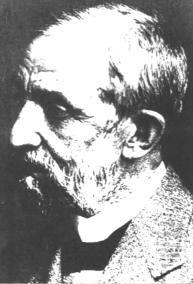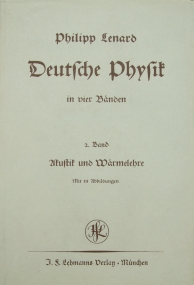“Our old fights were sure victorious; only few obstinate people are still grouping around the Captain of Koepenick. The youth however clearly knows about German physics and Jewish physics;…”
Philipp Lenard in a greeting card to his colleague Ernst Gehrcke, June/July 1937
Short life history: Philipp Eduard Anton Lenard
* June 7, 1862 Preßburg, † May 20, 1947 Messelhausen
After his study of science in Budapest and Vienna and physics in Berlin and Heidelberg, Lenard obtained a doctorate in Heidelberg in 1886. He went to Breslau in 1890 as assistant and a year later to Bonn to Heinrich Hertz (1857–1894) where he also qualified as university lecturer. Then he changed to Aachen, Heidelberg and Kiel. Back in Heidelberg in 1907 he became head of the Physical Institute there. From 1909 he was leading the Radiological Institute at the University of Heidelberg which was also founded by him. He stayed at the University of Heidelberg until he conferred emeritus status (1931). After the war Lenard moved to Messelhausen (Badenia).

Quite a few of his basic works dealt with the phosphorescence and experiments concerning the photoelectric effect (theoretical interpretation by Albert Einstein in 1905). Furthermore he developed a model of an atom (dynamids model) which is said to be the predecessor of the model of an atom by Ernest Rutherford. In addition he worked in the area of conductivity of metals and the electricity of waterfalls. For the year 1905 he received “… for his work on the cathode rays…” the Nobel Prize for physics. In these works he examined, among other things, both the electrostatic properties of cathode rays and their magnetic deflection.
With the beginning of the 20ies he became one of the most inveterate foes of Einstein’s theories of relativity. This rejection, founded on an excessive nationalism in connection with a strong anti-Semitism, became stronger as time passed by and reached its critical stage after the national socialist seizing of power (1933). One of his followers was the physicist and Nobel Prize laureate Johannes Stark (1874–1957).
In Lenard’s four-volume work of 1936/37 “Deutsche Physik” (German Physics), written on the basis of classical physics of the 19th century and with the accentuation on experimental physics, the theoretical i.e. Jewish physics was almost completely rejected.
Philipp Lenard: “Deutsche Physik” (German Physics)
Volume 1:
Einleitung und Mechanik (Introduction and mechanics)
Volume 2:
Akustik und Wärmelehre (Acoustics and thermodynamics)
Volume 3:
Optik, Elektrostatik und Anfänge der Elektrodynamik (Optics, electrostatics and beginnings of electrodynamics)
Volume 4:
Magnetismus, Elektrodynamik und Anfänge von Weiterem (Magnetism, electrodynamics and beginnings of further physics)


Illustrations Credits:
Courtesy of the Schleswig-Holsteinischen Landesbibliothek Kiel: 1
Archives of the author: 2


 DEUTSCH
DEUTSCH